| Aurix | |||
|---|---|---|---|

| |||
| General Information | |||
| Classification | Ovokentron ultravenator | ||
| Homeworld | Vuunega | ||
| Environment | Deep Mangrove, Zeeon | ||
| Intelligence | Sapient | ||
| Biochemistry | Carbon-based lifeform | ||
| Biological Information | |||
| Lifespan | ~20 years, 7 months | ||
| Locomotion | Bipedal walking, balanced on tentacles with tail for some counterbalance | ||
| Feeding Behavior | Carnivore with supplemental herbivory | ||
| Prey | Rockscale (annual meal) Grendon Quirlax | ||
| Predators | Aurosuchus Gargantua Wray Neomwa | ||
| Cladogramatical Information | |||
| Cultural Information | |||
| Personality | Cautious yet intelligent, but vicious in combat | ||
| Organization | Batteries | ||
| Language(s) | "Electroplaque Speech" (primary) "Vocal Speech" (secondary) | ||
| Affiliation(s) | Independant | ||
| Scientific Taxonomy | |||
| Planet | Vuunega | ||
| Domain | Monocentralis | ||
| Kingdom | Neomalia | ||
| Subkingdom | Omnicleofian | ||
| Infrakingdom | Zygodermata | ||
| Phylum | Notochordum | ||
| Subphylum | Vertebratus | ||
| Infraphylum | Gnathostoma | ||
| Superclass | Bipodomorpha | ||
| Class | Chlorosymbiota | ||
| Subclass | Therocoelognathus | ||
| Superorder | Tentacleiosaura | ||
| Order | Chlorosauridae | ||
| Suborder | Carnochloroilae | ||
| Superfamily | Kritognathus | ||
| Family | Troonychus | ||
| Genus | Ovokentron | ||
| Species | ultravenator | ||
| Other Information | |||
| Status | Least Concern | ||
| Creator | Somarinoa | ||
Aurix (pronounced \ɑːrɪks\) are sapient tentacleiosaurs indigenous to the planet Vuunega. They are the second Vuunegan species to rise to sapience—the first being the mysterious Zomm.
Statistics[]
- Locomotion: When on land, Aurix walk bipedally with average-length legs, and are balanced by their head and tentacle-arms on one side and the curvature of their tail on the other. When in water, they use undulations of their body with the occasional water jet push, and sometimes will paddle inneffectually like a frog with both feet—arms typically are held forward.
- Environment: Amphibious; spends much of its free time underwater, yet hunts on land.
- Diet: Quirlax and Grendon meat, combined with photosynthesis obtained due to their symbiotic relationship with the Chlorolomba. Whipscales are fed upon annually when available and are considered something of a delicacy.
- Average Lifespan: ~20 years, 7 months (estimate taken during semi-sapience)
- Personality: Cautious yet intelligent, but vicious in combat
- Affiliation: Independant
- Archetype(s): Warrior
- Primary language(s): Unnamed covert electroplaque communication, Unnamed vocalizations
- Alignment: Chaotic neutral
- Biochemistry: Carbon-based lifeform
- Lifestyle: Social Predator
- Hunt/Forage Success Rate: 60% Hunt (80% success rate), 40% Photosynthesis (99.7% success rate during day, 5% success rate during night)
- Armor: Aurix possess very little natural armor, namely consisting of a leathery neck plate across the top of their neck (but not the lower section), and shark-like dermal denticles which cover their entire body as a type of scaling. These dermal denticles are also strengthened in order to support and anchor more powerful swimming muscles throughout the body, and thereby serve a dual purpose in this fashion. Besides this, the Aurix have yet to reach sapience. Due to their lower amounts of armor, they can die moderately easy when an attack gets through their offenses and defenses.
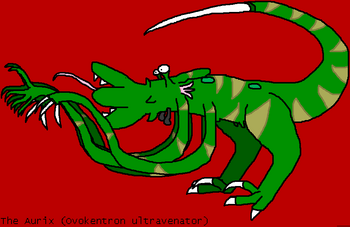
A nude Aurix, showing its physiology.
- Defenses: Aurix possess electroplaques stored in their tails, which produce a low amp voltage capable of causing both dizzying discomfort and weak migraines able to cause incapacitation to terrestrial foes as well as being capable of dealing actual physical harm to their more aquatic opponents. They also possess weak poisonous skin and decent poison resistance, as well as their bony skeleton, which has been strengthened by thicker bones, chiefly in the ribs and legs. They also possess both a leathery neck plate and dermal denticles, which are described above. Their skin coloring helps them blend in with the murky swamp waters, as well. Despite these defenses being relatively weak, they can use their natural intelligence to escape harm, as well as their amphibious habits.
- Weapons: Aurix possess a row of cnidocytes on either side of all four of their tentacle-arms which possess weak neurotoxin to incapacitate smaller prey or creatures with thin skin. They also possess a radula which usually lies within a tiny "nook" deep within their split jaw mouths; when used, it sticks out this tongue and whips it around, trying to saw against chitinous armors, although with less success as it did when the species possessed their ancient proboscis. However, this weapon has fallen into rapid disuse due wholly to their stomachs now possessing enough acidic content to successfully digest chitin, allowing them to just swallow their armored prey (however, they also no longer feed on any species of arthropoids, and therefore the adaptation has become vestigial). As mentioned earlier, they can also use their electroplaques to stun or even kill some prey. Another weapon they possess a large bone stinger at the tip of their tails, which possesses a hollow center in order to release venom by way of a venom sac located at its base. They possess a spitting organ as well, which they use to fire a projectile venom attack from their mouths at foes, sometimes from the safety of their watery homes, like some kind of poisonous archer fish. The more recent addition to the Aurum's arsenal is elongated claws on its second pair of tentacle-arms; these are used to rake at prey (generally Grendons but also the occasional Quirlax) during hunts, or even at foes during fights; this has even more recently been supplemented by a pair of killing claws on their feet, located on their inner toes—these can be used to attack prey either by slashing from a standing position or jumping at prey, where they can inflict relatively deep wounds. The final weapon they possess is the split jaw mouth itself—known as the death petal, which is actually separated into four jaws, allowing it the capabiliy to open wider than a regular mouth to bite huge chunks of meat from foes and prey. This mouth is filled with a large complement of very sharp teeth, which are used for tearing rather than chewing; this means the Aurix, when feeding, typically tear large chunks off of prey, and then set this down, and tear it into smaller chunks that will successfully glide down their esophagus.
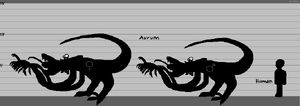
Original size comparison between Aurix sexes and an average Human.

Updated size comparison between Aurix.
- Tools: Two pairs of tentacle-arms, capable of simple manipulation of objects, or for wrapping around prey. The first pair of these tentacle-arms possess a split tentacle style of hand (which is formed when the tentacle-arm splits into four or five shorter tentacles, which are used like makeshift, yet far more flexible, fingers), designed to allow further manipulation of objects. The second pair possesses hunter's claws, which are long and slender; they are used for raking against foes and prey alike. However, they are also capable of a little manipulation.
- Method of Eating: Grab prey with tentacles, using split-tentacles, if needed, hunter's claws to hold on. Certain prey is incapacitated by injecting them with cnidocytes that line the arms. Other prey that possess hard chiton shells incapable of either fitting the mouth entirely around or too tough to crack, use of radula to wear through armor is not uncommon. Bring prey to split jaw mouth and tear off large chunks of meat off of prey. If chunk is too large to immediately swallow, can either set food down and tear smaller chunks off until entire thing will fit down the esophagus, or use smaller, inner teeth (adapted from proboscis barbs they once had) to tear and chew the meat until it is in small enough chunks to fit safely down the esophagus and into the stomach, where digestion begins. After being processed within the acids of the stomach, it descends into the intestine, where nutrients are partially digested by the body, with wasted remnants excreted out the anus on the opposite end.
- Reproductive Rate: Sexual maturity is reached after 5 years. Can reproduce any amount of times during their lifetime, although they generally will limit themselves to twice during their lifetime.
- Gestation: Under Rehaul—Outdated information located below:
3.5 weeks then lays eggs—eggs are laid in nests dug out of sand, dirt, and/or mud and formed into a shallow bowl shape through the use of natural enzymes excreted through their cloaca, combined with the processes of their ptchocyst nematocysts, which when combined work like a type of glue to hold their nests together (the ptchocyst works as a waterproofing seal). These nests are built within the shallows of their swampy home, as the eggs still need the air to breathe, as an Aurix cannot breathe underwater forever, and therefore the eggs still need to remain above the surface of the stagnant lake.
- Offspring Incubation: 4 weeks until egg hatches after being laid.
- Number of Offspring: 10 aurumlings per litter
- Offspring Survival Rate (before age of maturity): 46%—the Aurix are a very intelligent species, and while they take care of young aurumlings, they no longer pay nearly as much attention to their nests and eggs, with parents preferring to mostly leave them be except in order to replace the air bubble in their aquatic nests periodically. Both parents will spend time doing this for their eggs and spending a small amount of time during each session "bonding" with their eggs. If both parents should somehow die, the rest of the colony will take over for them. After hatching, young must instinctively swim towards the nearby shore for the protection of their parents, who will pick them up (as despite being able to swim, they are still unable to walk on land). Small pits are still utilized to keep track of aurumlings who are still too young to walk, but after two weeks, they finally learn to do so, and can leave the pits in order to follow their parents around and play with each other. After 3 weeks they learn how to swim for extended periods of time without tiring as easily, and can enter deeper waters, although still must stick close to the colony to avoid being eaten or lost. Most deaths occur before this stage, and typically in first-time mothers or when the new aurumlings flee towards the colony. Egg thieves may also advance on the nests occasionally and rob them before hatching ever occurs.
- Singular/Plural/Possessive: Aurum / Aurix / Aurixan
Food Chain[]
Prey[]
While not exactly highly-specialized predators, they are pack hunters who focus on only a few particular species for their sustenance. In times of starvation, they are said to occasionally resort to cannibalism. Minus their own kind, only three species are known to grace the Aurixan stomach linings.
Predators[]
The Aurix are certainly not considered an apex predator, and are viewed as a welcome food source to a number of species. While other colonies might know which species specifically predate upon them, the West Shore Aurix (which the storyline follows) only know a few species who feed upon their delectable flesh.
- Neomwa
- Gargantua Wray
- Aurosuchus
- Dorian in the book,The Dorian
Physiology[]
Below you will find information on the Aurixan physical appearance, and explanations of details spanning from (but not bound to) their skeletal structure to their senses.
Skeleton[]
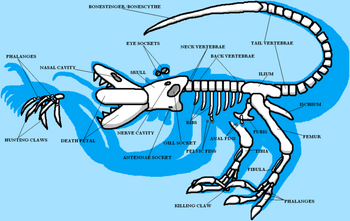
An Aurixan skeleton of ovokentron ultravenator. Diagram points out most bones.
The Aurix possess a simple skeletal structure, capable of simple abuse without breaking. This however is not to say that their skeletal structure is brittle.
The Aurixan skeleton is typical of those that you might find in your every day Earth-bound creature. The skeleton consists of 28 vertebrae from the base of the neck to the end of the tail/beginning of the scythe stinger, with only two vertebrae in the neck, nine making up the ribcage, and seventeen in the tail. The tentacle-arms do not possess a single bone within them, as the Aurix rely strictly on muscles to move their manipulators.
The skull however is worth mention. It had for millennia been long, consisting of two separate bones which had eventually fused to strengthen both, which were the skull itself and the proboscis; used in the Aurix's old hemophagic tendencies. Eventually after many, many centuries of evolution, the proboscis bone melted away, leaving a gargantuan hole in the front of the skull, where a mouth formed instead. This mouth, known as a razor gullet, was full of twelve razor-sharp teeth which had actually been adapted from the various barbs that could once be found attached to the proboscis, flanking it to help aid the Aurum in battle. Eventually, this too had disappeared, having elongated outwards over time, leading to a far more useful tusked trap mouth which sat in roughly the same hollow spot in the skull. This large hollow remains to some extent, leading to them still being included in the Therocoelognathus subclass, which means "Jaw Opening Beast". But, like the razor gullet before it, the tusked trap has also disappeared; the bones making up this mouth were four extensions of the minuscule remnants of the proboscis, and as time went on, they no longer were held together by encapsulating flesh but instead allowed to separate, forming the split-jaw, more commonly known by its nickname, the Death Petal. This weapon is on the cutting edge of mouth evolution, and awards the Aurix a savage, massive bite.
Another point of interest is the eyes, which are set into eye socket bones. Curiously, these eye sockets are not attached to the skull at all and instead float within the fleshy eyestalks which extend outwards, up, and forward from the skull itself. It is also interesting to note that they still possess both pelvic and anal fins, which are leftover remnants from their ancient seafaring ancestors.
Aurix walk bipedally, walking on two legs that extend straight down due to an ornithischian, or "bird-hipped" style pelvis, which they are balanced upon by their tentacle-arms and tail, although the tail now typically extends over their heads in a likeness to a scorpion. Their feet are designed almost like a hybridized cross between a miniature tyrannosaurus and a dromeosaur's feet, and possess very little climbing ability, although the Aurix are indeed capable of climbing—albeit slow, weak and clumsy, by using their tentacle-arms to wrap around tree branches or other things and then digging their toes into whatever is around, pushing themselves up with their legs while pulling themselves up with their arms.
The tail bones are designed to allow the tail to comfortably rest while curled over the top of the head, which comes to a dangerous end found in the form of a curved and somewhat sharp extended bone stinger, sometimes referred instead to as the bonescythe or bonestinger. Over time this bone adapted to become hollow and now sports a venom sac at its hilt, filled with the same neurotoxic venom found in the mouth's venom sac, which helps an Aurix with its offensive tactic of stinging. The tail has become rather stiff and inflexible in most directions in order to allow the tail to sting forward more powerfully, but is capable of being uncurled and held flat; it is typically held in this manner during swimming.
Musculatory System[]
The Aurix musculatory system is far from fancy or spectacular. Typical muscles criss-cross areas, although more muscles inhabit the mouth than your typical creature, from a time when they possessed movable teeth used to push food down into the esophagus (many of these muscles are now unused and atrophied), while other muscles power the four-way biting mechanism. Muscles exist that are more powerful in the tail and although once used for their main propulsion system through water, it is now typically all used for a powerful strike in their bone scythe stingers which have become their main line of offense.
Circulatory System[]
The Aurix circulatory system is fairly uninteresting, although it should be noted that they possess both full-fledged lungs and feathery gills, which remain closed thanks to muscular "gill flaps" while not in water. These gills stem from their days as spinocephalopods and allow them a highly extended time period in which they may remain underwater, although they still need to gulp down large breaths of air before submerging due to the relatively small size of the gills in comparison to the rest of the body; the gills just do not provide enough oxygen into their system as they stand.
Brain & Nerve Center[]
The Aurix have become extremely intelligent over time, with each possessing the approximate intelligence of a dolphin. Although they had long spent their time in the protection of schools and then in packs known as cetes, they have since separated into even more family-oriented pods, ruled by an alpha male and alpha female. These groups are capable of becoming significantly larger than the old cetes, with the cetes only being able to contain 30 members while the batteries (the new term for a group of Aurix) can now hold up to 50 members.
Although they once held colonies, first in a porous rock known as Colony Rock in the Vuukelp Forest, then in the koryl tethers beneath the Urn Koryl of the Koryl Reef, and finally upon horse-sized Titan Wrays swimming the oceans around the Reef, they eventually worked their way into a large Tidal Pool area close to the southern shore of Zeeon, where they hadn't possessed a colony in some time. With the overtaking onto land and the evolution into tentacleiosaurs they have returned to their colonial lifestyle, using permanent nests that they make repairs and improvements to every "mating season".
They try to protect their young as well as other members with their lives and are less likely to leave their old, sick and dying behind, and instead are likely to stay as a battery and protect them by driving off the would-be predators. They also protect their deceased from the various brilliantly-colored Featherhead that roam the beach and occasionally enter the surrounding Catapult Forests and have even gone so far as to protect a fallen Quirlax from a large flock of starved Featherheads.
With the onset of the Permitted crash-landing, they have also become experts at sneak attacks; however, it is unknown if the other colonies are capable of this or if it is only a learned tactic of the West Shore Aurix.
Digestive System[]
The digestive system is a simple one, with the Aurix possessing only a stomach and one set of intestines to process their meals. They also possess a vestigial organ known as the Blood Processor—not found in many species on other worlds—which is specifically designed to process all the nutrients out of a strictly-blood diet.
The stomach acids have grown powerful enough to properly process chitin, although are still incapable of processing metals like the Human's stomach can. The intestine works like a large intestine, and is filled with various microorganisms which help break down nutrients and absorb them into the body. The Aurix are known for feeding exclusively on only three species, although they often scavenge off of any dead opponents they have recently killed. These three species are:
- The Whipscales, a strange organism known as a Xenosurin, possessing metallic armor plating on its upper shell. These beings often wash ashore along the southern beaches in an earlier form known as Rockscales, where they are eaten by Clawgrips and Skullbeaks. While sessile in their initial stage, they soon grow limbs and eye-like sensory organs and crawl up the beach, where they settle down once more and return to their sessile habit. Only those Whipscales who are spotted by the Aurix during their annual migration into the Catapult Forests are considered edible and are essentially no more than a delicacy to them.
- The Grendons, an offshoot species of the Aurix that have remained spinocephalopods rather than converting into tentacleiosaurs, like many other terrestrial offshoots have done. These strange-looking "back-boned mollusks" stand on four heavily muscled tentacle-legs and have one set of thin tentacles that are covered in razor-sharp teeth used for offensive maneuvers. They feed upon the Quirlax and are the natural rivals of the Aurix race.
- The Quirlaxi, another offshoot species of the Aurix genome that converted into tentacleiosaurs alongside the Aurix. For a time, they were under the Aurix's protection but that symbiosis has fallen away to predation. Unlike other offshoots, the Quirlax specialize in a herbivorous diet.
Respiratory System[]
Aurix belong to a unique taxon of tentacleiosaurs which possess both gills and lungs, allowing them to breathe properly in both environments. The Aurix species prefer to spend a significant portion of their lives on land; but will swim around in the swamps on occasion as they do not have any requirements such as prey located therein. Both gills and lungs are fully developed, although the gills are considered too weak to indefinitely extend water breathing as they are built more for cat-sized creatures, whereas the Aurix are now horse-sized. The gills possess muscular flaps that are typically closed while on land in order to prevent their drying out. These muscles are controlled by the subconscious, preventing them from drowning due to lack of experience with them, such as if their nest while still full of aurumlings were to flood over for some reason. The Aurix currently can stay underwater for up to an hour before needing to return for a breath of fresh air.
Senses[]
The Aurix hunt particularly by sight and electroreception as most of their other senses remain weak and unadapted. Aurixan eyes are set within thick eyestalks, with the eyes themselves capable of human-equivalent chromatic vision with focusing allowing them to see up to a half-mile away, although not in tremendous detail. These eyes have also become capable of sight so long as there is some form of light source, again like human eyes.
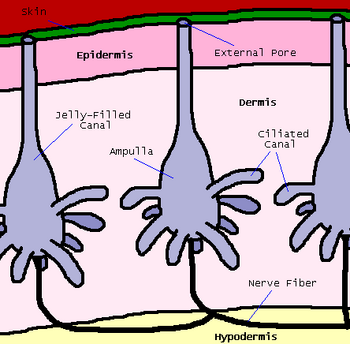
An Aurix's ampullae of lorenzini. It is many times stronger than those found on any known Earth species.
Their main sense is actually electroreception. Along the sides of their head are located several very sensitive ampullae of lorenzini; specialized jelly-filled canals which open to the surface by a pore in the skin and end blindly in clusters of small pockets and canals full of electroreceptor cells. These are used to detect objects (typically living objects) through the use of electroreception. The Aurix have increased this to such a powerful level that they can detect bioelectrical life signs up to a mile away in 100% salinated marine waters. While this is considered an extreme ability, its range is significantly lowered in brackish water to a half-mile distance, while in freshwater it is only a surprising 25% range. On land, it is lowered to 10% of its natural range, although this can be increased or decreased depending on the local humidity level.
Although they do not possess the necessary means to smell through their nostrils, they have adapted a pair of insignificant, downward-facing clubbed antennae that they can gently brush against the ground. These serve the purpose of smelling, although they are rather basic and are not particularly great at tracking.
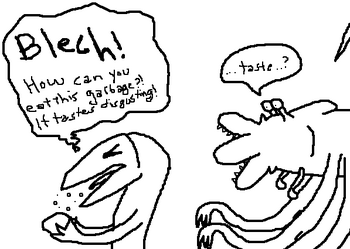
A humorous, non-canonical encounter between an Aurix and a Commati, detailing the Aurix's lack of taste sensors.
Aurix also possess simple nerve endings to allow them to know generally how cold or warm an area is to prevent both overheating and freezing, which is good considering the fact that they remain a cold-blooded species.
Other senses they possess include simple internal ears (primitive tympanic ears), basic magnetite sensors for magnetoception and very weak extra-sensory perception, used specifically to detect things like earthquakes or huge storms up to an hour before they happen.
However, they have yet to gain any form of taste, which is a strange trait to be found. They also do not possess any form of echolocation, although this is a far less strange occurrence and is actually seen as relatively normal.
Trivia[]
- A group of Aurix is called a Battery.
- The Aurix were not the first sapient species on their planet. A mysterious race calling themselves the Zomm once lived on Vuunega before a collision with a comet wiped out 99.9% of the planet's lifeforms a billion year ago in a huge cataclysmic event.
- Aurix lead a symbiotic life. They have carried a chloroplast symbiote called the Chlorolomba since they were rather simple cells, which could give their hosts energy in the form of photosynthesis. These symbiotes now reside in "cluster organ buds" which reside for the most part just below the surface of the skin, although a certain amount of this sticks out slightly in a "bud" shape, allowing greater cluster organ surface area. The skin above these cluster organs is translucent and thinner than the rest of the skin, allowing light to pass through easier. The Aurix themselves are carnivores, feeding chiefly off of both the Grendon and the Quirlax. They are entirely capable of killing their prey, and are excellent hunters.
- They possess a weak neurotoxin in the cnidocytes that line their tentacle-arms, which is released by will rather than automatically. They also have slightly poisonous skin.
- The Aurix Interactive Spore FanFic Game was started on the GameFAQs Spore Message Board on Saturday, March 25, 2006. Since then, the Aurix went through over 104 rounds of evolution, failing to actually acquire sapience, although they got close. The game unfortunately was halted after Spore came out, as no one was willing to play the forum games any longer.
Galleries[]
Neogenetic Hybrids[]
Hybrids come in three fashions: natural hybrids, caused by the natural union between individuals of separate but closely related species; neogenetic hybrids, created using a brand of near-perfect genetics called neogenetics that allows any and all species to genetically co-mingle, as well as allowing for a target of the use to mutate from the hybridization post-birth; and forced hybrids, created by a species forcing itself into another and purposefully altering its DNA, or using its DNA to separately create new entities based off the original creatures.
Offshoots and Ancestors[]
Many species split from the original Zocellium that existed in the oceans of Vuunega during the Great Catacylsm. Not all of these survived. Those who led directly to the evolution of the Aurix are known simply as ancestors for obvious reasons. Those which split from that lineage to form new, varied lineages of their own are known as offshoots. Technically speaking, one new offshoot branch was formed during each chapter of The Vuunega Chronicles, and each chapter after an offshoots' creation, that offshoot spawned its own offshoot. The Aurix family tree has therefore blossomed quite beautifully over the eons.
Offshoots and ancestors currently without images available are the †Aurii, Aurosuchus, Grappra, Guirlath, †Neomva, †Neomxa, Neopatra, †Neouii, †Squillix, Squolf, †Zoca, †Zocellium, Zrrnigor and Zrrnigoth. When images are made available, they will be added to the gallery as well.
Miscellaneous Images[]
This gallery is for all the miscellaneous Aurixan images I have created over the years. Fan art will also be featured here since there is not a huge amount of it so far.




























